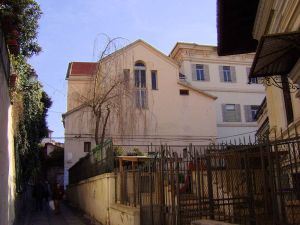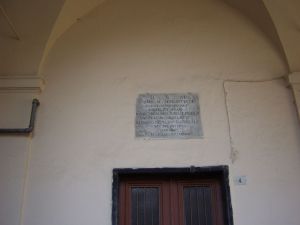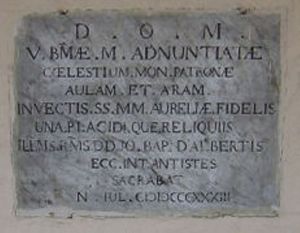Convent and church dedicated to S.S Annunziata
The history of the Monastery
The foundation of the first monastery of the nuns of the Santissima Annunziata, called Turchine because of the colour of their robes, was due to the initiative of three young women from Sanremo, who lived by strict religious rules and were called "nuns" even though they did not belong to any monastic order: Sister Angela Bottino, Sister Maria Anselmo and Sister Caterina Anselmo.
After having decided in 1635 to found a women's monastery in Sanremo, which was still missing in the whole western part of Liguria, the three nuns entered the cloistered Monastery of the Annunziata in Genoa, in the area of Castelletto, and in about two years they managed to accumulate (in oblations and above all with the munificent help of the nobleman Silvestro Grimaldi) a substantial sum (about 4,000 lire of Genoese) to be used for the realization of the institution.
Officially welcomed in the Genoese convent of the Santissima Annunziata in October 1637, the three matuzian nuns finally obtained on 7th May 1638 the long-awaited papal consent to the foundation of a new monastery in our city, where on 26th March 1639 Sister Angela Bottino and her sister Maria Anselmo returned, accompanied by the magnificent Silvestro Grimaldi, to start the procedures for the institution of the new convent.
The Borea Manuscript which, among the various inaccuracies that distinguish it, however, continues to be a direct and indispensable source for the history of Sanremo and in substance reproposes the story of the Convent but with substantial distinctions that are worth producing.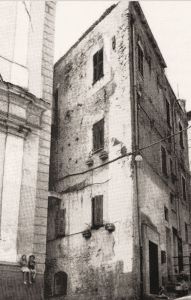
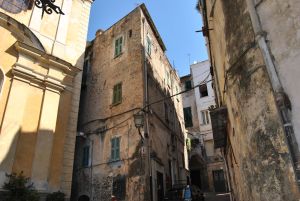 The Order of the Religious erected a first small convent in Sanremo in 1636, near the present parish of San Giuseppe, in a place still today indicated as the "Old Sacristy".
The Order of the Religious erected a first small convent in Sanremo in 1636, near the present parish of San Giuseppe, in a place still today indicated as the "Old Sacristy".
It was founded by the nun Maria Anselmo, advised and protected by the Genoese patrician Silvestro Grimaldi, as we read in the chronicle of that year, but without mentioning the other women, there is a mention of the collaboration of a certain number of Beghine: reading also shows disagreements on the choice, rather casual, of the Order of the new convent and the one, rather obligatory, of the primeval seat.
However, the powerful Genoese protector did not like the choice of the place: he preferred a beautiful and grandiose building under the walls of the old city, where the verdant plain of orange and lemon trees began.
The need to erect a new Conventual House of the Monache Turchine (Monache Celestine) of Sanremo can be read in the chronicle of the year 1639; instead from the chronicle of 1640 we learn about the bureaucratic and notarial practices for the purchase of the new seat.
As far as the structure and urban evolution of the building is concerned, we can say that in 1637 the Parliament of the Community decided to assign to the nuns of the Santissima Annunziata an unbuilt site of four hundred palms, relieving themselves of any other burden deriving from the new building, on the condition that the Tuchine, in charge of running the monastery, undertook to start work on the new building within a year of the relative resolution. 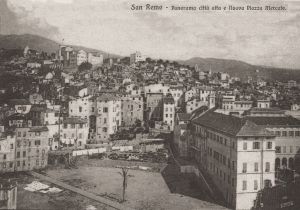 After examining various proposals regarding the ideal area in which to erect the monastery, in the end the most suitable land was identified in a vast area with vegetable gardens, in a city area affected in the seventeenth century by considerable building development and located outside the city walls, on the slope of the San Romolo stream along the route of today's Via Morardo, which connected the Ciapéla with the church and the Porta Santo Stefano near the square built around 1625, overlooked in 1667 by the Palazzo del Commissario.
After examining various proposals regarding the ideal area in which to erect the monastery, in the end the most suitable land was identified in a vast area with vegetable gardens, in a city area affected in the seventeenth century by considerable building development and located outside the city walls, on the slope of the San Romolo stream along the route of today's Via Morardo, which connected the Ciapéla with the church and the Porta Santo Stefano near the square built around 1625, overlooked in 1667 by the Palazzo del Commissario.
On 9th October 1639 the prioress Sister Cornelia Centurione, the subprioress Sister Geronima Spinola (of the powerful Genoese marquises Spinola) and the first ten novices of the order made their solemn entrance, accompanied by the two godmothers for the inauguration of the new headquarters, Maria Pallavicino and Anna Serra and by the three Sanremo nuns who promoted the initiative, Sister Caterina, Sister Maria and Sister Angela.
When Sister Anselmo died during the works she was directing with skill and energy, perhaps followed by the work of the benefactor Silvestro Grimaldi, other nuns came from Genoa to continue the work; the superior, Sister Girolama Spinola, a prudent and very skilful woman, completed the construction and organised major religious and popular events for the inauguration.
The famous secentist Frugoni gave great praise to this monastery when he described the visit of the Princess of Monaco, Grimaldi Aurelia.
On 1st October 1641 the mother prioress asked the representatives of the City Council to place the nuns and the monastery of the Santissima Annunziata under the protection of the Community of Sanremo. 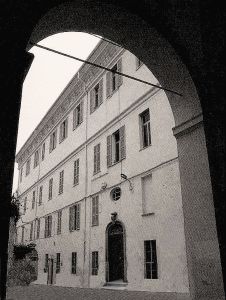
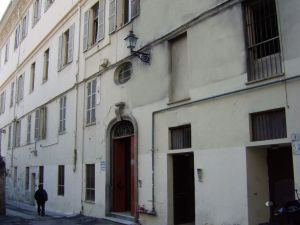 Gathered the Parliament on 27th September 1642, in the presence of the podestà, the assembly approved by a large majority the proposal of the mother prioress and assured her moral support in order to finally provide the Order of the Turks with a larger monastery worthy of the importance assumed in the meantime by the congregation, on condition that all expenses would be borne by the nuns.
Gathered the Parliament on 27th September 1642, in the presence of the podestà, the assembly approved by a large majority the proposal of the mother prioress and assured her moral support in order to finally provide the Order of the Turks with a larger monastery worthy of the importance assumed in the meantime by the congregation, on condition that all expenses would be borne by the nuns.
The new Convent of the Turks was officially opened on Ascension Day on 14 May 1643.
On 15 May of the same year the population of the "Pigna" solemnly accompanied the nuns to the new monastery and participated with enthusiasm in the great celebrations presided over by the Bishop of Albenga who celebrated the first Mass during which the Sanremo Innocenza Maruffa and Paola Girolama Poggi wore the cloistered habit.
The expenses for the construction of the imposing building, however, soon exceeded the wider forecasts, so much so as to induce the town council to intervene in a timely manner, deliberating, in the meeting of 1 April 1644, in accordance with what was permitted by the Genoese laws in force at the time, to impose on every Sanremo family the obligation to provide a day's work free of charge in order to be able to complete the construction of the monastery in a reasonably short time.
This was the famous sequel, that is, the obligatory work for all citizens, to which the various Municipalities sometimes resorted, but only to carry out urgent works of public utility, as was evidently considered the erection of the Turchine convent.
Around 1660 the nuns of the Santissima Annunziata moved from the house near the church of San Giuseppe to their new home a few steps away from the town hall. 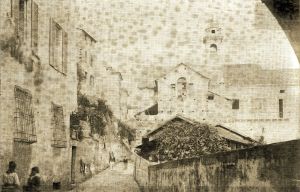 The primitive monastery, which was rather small in size and to which a small east-facing church was also attached, soon proved to be completely inadequate to accommodate the growing number of nuns who flocked to our city to settle in the convent of the Turks, who, having also noticed the multiplication of religious vocations, were forced to equip themselves with a much larger and more spacious structure.
The primitive monastery, which was rather small in size and to which a small east-facing church was also attached, soon proved to be completely inadequate to accommodate the growing number of nuns who flocked to our city to settle in the convent of the Turks, who, having also noticed the multiplication of religious vocations, were forced to equip themselves with a much larger and more spacious structure.
For this reason, in 1668 it was decided to completely rebuild the monastery based on a project by the Genoese architect Pietro Antonio Corradi (c. 1613 - 1683), author of the plans for numerous noble palaces in Genoa, including the famous Palazzo Rosso, and who, the previous year, had realised the original design of the nearby Palazzo del Commissario in the current Piazza Nota, seat of the offices of the vicariate of the Western Riviera, and had undertaken the construction of the convent of the Canonichesse Lateranensi in Ventimiglia.
At the same time as the decision to rebuild the monastery, Marco Antonio Lomellino and Filippo Maria Pinelli, representatives of the Senate of the Republic, were also appointed as protectors, Agostino Olignano, Paolo Gerolamo, Gio Maria Orenghi and Gio Francesco Orengo, who were assigned the task of supervising the work of the new building, according to the plan prepared by the architect Corradi. 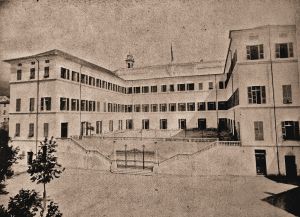 The convent, originally composed of fourteen rooms, was to be completed within two years, as agreed with the masters Lorenzo Dolio of Ventimiglia, Gio Batta Aicardi and Stefano Merlo of Sanremo.
The convent, originally composed of fourteen rooms, was to be completed within two years, as agreed with the masters Lorenzo Dolio of Ventimiglia, Gio Batta Aicardi and Stefano Merlo of Sanremo.
However, the scarcity of documentary sources does not make it possible to follow the construction of the new building with precision, even though an act of 1680 between master Vincenzo Stefano and master Giacomo Martino of Monaco concerning the construction of an altarpiece ordered by the prioress of the convent, it is possible to deduce that at that time the church was practically finished, while in November 1690 the monastery was still under construction under the direction of the head of the building Stefano Merlo.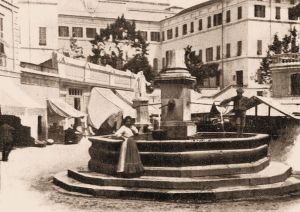 The building, which underwent further modifications during the eighteenth century, consists of a large body with a U-shaped plan, at the gates of the Pigna district on slightly sloping ground.
The building, which underwent further modifications during the eighteenth century, consists of a large body with a U-shaped plan, at the gates of the Pigna district on slightly sloping ground.
The two wings are kept at the height of the narrow upper street (via Morardo) by means of a high shoe base and connected with the square below, then again piazza Nuova, by means of a wide staircase, which makes the whole complex particularly monumental. The architectural layout is, however, structured in a rather simple way, with uniform fronts highlighted by stringcourses and windowsills, while the definition of the volumes is carried out above all by a protruding cornice supported by stylised corbels.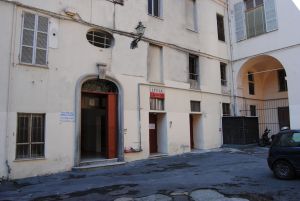 The life of the convent flourished among the public appreciation until the middle of the 19th century when it was suppressed, with the public requisition of the property, in accordance with the dictates of the anticlerical laws of the time (still in the Borea Manuscript it is read as that of the Turchine, in 1810 it was one of the four Convents of Religious that the Napoleonic Administration, in its reorganization of the clergy, did not suppress in the western part of Liguria).
The life of the convent flourished among the public appreciation until the middle of the 19th century when it was suppressed, with the public requisition of the property, in accordance with the dictates of the anticlerical laws of the time (still in the Borea Manuscript it is read as that of the Turchine, in 1810 it was one of the four Convents of Religious that the Napoleonic Administration, in its reorganization of the clergy, did not suppress in the western part of Liguria).
With a view to improving the streets, in 1816 the Municipality undertook the enlargement of Via Morardo and the consequent opening of Piazza Corridoni in front of the Turchine Convent.
Restored to the faith, the Convento delle Turchine was ceded in 1881, by the government to the Municipality of Sanremo.
The public schools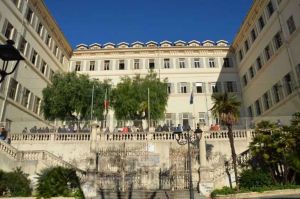 After the secularisation of the building, the Turchine family abandoned it for good, and the nuns who were housed there obtained a severance pay, so the vast building was chosen by the municipal authorities as the seat for the students and teachers of the Royal High School named after the astronomer Gian Domenico Cassini, who moved from the premises of the former Jesuit convent and remained there continuously until the 1966/67 school year, when he was to move into the building, formerly the Hotel Excelsior, located in Corso Cavallotti next to Palazzo Bellevue.
After the secularisation of the building, the Turchine family abandoned it for good, and the nuns who were housed there obtained a severance pay, so the vast building was chosen by the municipal authorities as the seat for the students and teachers of the Royal High School named after the astronomer Gian Domenico Cassini, who moved from the premises of the former Jesuit convent and remained there continuously until the 1966/67 school year, when he was to move into the building, formerly the Hotel Excelsior, located in Corso Cavallotti next to Palazzo Bellevue.
In 1885, the citizens of Sanremo demanded a Technical Institute which they now felt the need for; despite the incomprehension and hostility of the councillors, the mayor Asquasciati managed to launch it.
However, another serious difficulty immediately arose: the fierce opposition of the Royal Technical Institute of Porto Maurizio, for which the municipal administration suppressed the new school.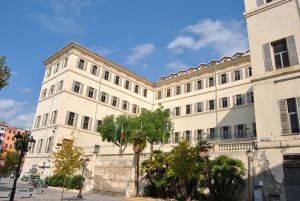 After the end of the First World War, the families of the pupils of the Technical Institute, who had to go to Porto Maurizio every day with great discomfort, submitted a request to the Mayor and the Royal Superintendent of Genoa; Sanremo finally managed to have its Institute.
After the end of the First World War, the families of the pupils of the Technical Institute, who had to go to Porto Maurizio every day with great discomfort, submitted a request to the Mayor and the Royal Superintendent of Genoa; Sanremo finally managed to have its Institute.
After a draw in 1921, it began to gather young people from the city and the neighbouring towns; it made its bones, developed and reached statization in 1957.
Recent needs imposed some, though questionable, upheaval of the building, with the construction of an advanced body on the façade at midday and, in the second post-war period, with the demolition of the church bell tower and the construction of the upper floors of the building destined to house not only the "G.D. Cassini" High School, but also the "I. Calvino" Middle School, the "C. Colombo" Technical Institute, the only school that is currently united in the old monastic house together with the local IPSIA.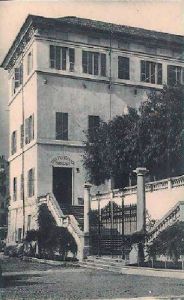 Currently the complex houses the "C. Colombo" State Technical and Commercial Institute for accountants and surveyors and the detached section of the State Professional Institute for Industry and Handicraft "G. Marconi" of Imperia, as well as the offices of various bodies and associations, including the Chamber of Labour of the CGIL and the Sanremo section of the ANPI, the latter located in Via Morardo.
Currently the complex houses the "C. Colombo" State Technical and Commercial Institute for accountants and surveyors and the detached section of the State Professional Institute for Industry and Handicraft "G. Marconi" of Imperia, as well as the offices of various bodies and associations, including the Chamber of Labour of the CGIL and the Sanremo section of the ANPI, the latter located in Via Morardo.
Today the old premises, embellished and completed with new classrooms, equipped with new and modern equipment for the scientific toilets, enlivened by the innovative spirit of the headmasters and the enthusiasm of its 400 students, is set to become one of the best Institutes in Italy.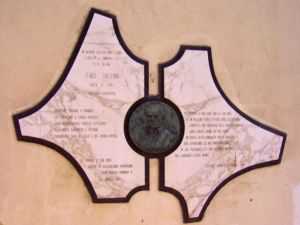 On one side of the facade facing Piazza Nota above the staircase leading down to Piazza Muccioli, on 25 April 1988, a memorial plaque commemorating the Sanremo writer Italo Calvino (1923-1985) was affixed on the initiative of the Municipality of Sanremo and under the auspices of the partisan associations. Particular mention should be made of his attendance at the local Liceo-Ginnasio "G.D. Cassini" in the premises of the former Turchine monastery.
On one side of the facade facing Piazza Nota above the staircase leading down to Piazza Muccioli, on 25 April 1988, a memorial plaque commemorating the Sanremo writer Italo Calvino (1923-1985) was affixed on the initiative of the Municipality of Sanremo and under the auspices of the partisan associations. Particular mention should be made of his attendance at the local Liceo-Ginnasio "G.D. Cassini" in the premises of the former Turchine monastery.
Between the two slabs that make up the marble table is a bronze effigy of the writer made by the sculptor Renzo Orvieto, while on the right slab is engraved the following passage taken from Calvino's autobiographical note mentioned in the collection "Ritratti su misura di scrittori italiani", published in Venice in 1960 by Elio Filippo Accrocca: "I lived in San Remo until I was twenty years old, in a garden full of rare and exotic plants... I fought with the partisans in the Garibaldi Brigades... in the same places that my father had introduced me to when I was a boy. So I deepened my identification with that landscape, and there I had the first discovery of the staggering human world".
The Church of the Turchine monastery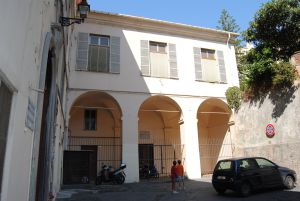 Today's main façade, which is very slim from a compositional point of view, develops along Via Morardo, which leads from Piazza Nota to Piazza Corridoni, which is also overlooked by the church, concealed on the ground floor by a triple-arched portico, surmounted by a space characterised by a sober and linear "civil" front.
Today's main façade, which is very slim from a compositional point of view, develops along Via Morardo, which leads from Piazza Nota to Piazza Corridoni, which is also overlooked by the church, concealed on the ground floor by a triple-arched portico, surmounted by a space characterised by a sober and linear "civil" front.
The singular position of the sacred building, decentralized and not amalgamated with the monastery building, undoubtedly reveals the addition of a planimetric variation to Corradi's original project, also supported by a document of the end of the 18th century, from which we learn that the church was not built on the site originally planned.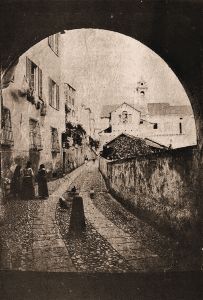 The architectural structure of the building, similar in layout to the church of Sant'Andrea in Moltedo di Imperia in 1666, is clearly marked by a polar arrangement with the central room, identified geometrically by a square with rounded corners, connected to four rooms of equal size but with different depths. The two transverse chapels are also harmoniously fused with the rest of the building, while the main walls, surmounted by sail roofs in the room and barrel vaults in the other rooms, are connected to the body of the church by means of voluminous pilaster strips repeated in the presbyterial area and in the large atrium.
The architectural structure of the building, similar in layout to the church of Sant'Andrea in Moltedo di Imperia in 1666, is clearly marked by a polar arrangement with the central room, identified geometrically by a square with rounded corners, connected to four rooms of equal size but with different depths. The two transverse chapels are also harmoniously fused with the rest of the building, while the main walls, surmounted by sail roofs in the room and barrel vaults in the other rooms, are connected to the body of the church by means of voluminous pilaster strips repeated in the presbyterial area and in the large atrium.
The decision to implement a central layout is almost certainly due to the influence exerted by the resolution adopted by the destroyed church of the convent of San Filippo Neri in Savona, dating back to 1650 and attributed to architect Gio Batta Ghiso, which represents one of the first examples in our region of sacred architecture responding to completely innovative spatial criteria. The church also stands out for the reduced size of the angular bevels, with the result of giving the whole building a general "Renaissance" layout.
After the convulsive Napoleonic period (despite the forced closure of convents of friars and nuns imposed by the imperial regime), the Turchine did not cease their activity.
The church of S.S. Annunziata was solemnly reconsecrated by the bishop of Ventimiglia Giovanni Battista D'Albertis on 7th July 1833, after having moved the relics of the martyred saints Aurelia, Fedele and Placido.
Divided into two floors, the former church, deconsecrated in 1937, was confiscated, together with the Convent, by the Municipality with the Siccardi Law of 1866.
In 1893, the Town Council decided to reorganise the gallery above the portico of the church of the former monastery of the Turchine and to put the private library, rich in medical, literary and scientific works in general, originally left in 1890 by the Sanremo doctor Francesco Corradi.
"Precisely to adapt to the needs of these two large schools, the monastic chapel was cut horizontally and divided into two floors. The upper floor housed the gymnasium and some classrooms of the IPSIA, while in the lower floor the apse area was occupied by the Library and the entrance of the church became the modern teaching room: after such transformations, architectural reading is no longer easy even if it remains quite simple to identify the Greek cross plan, some niches in the side walls and the cross vaults that characterize the first floor of the institute".
(cultura-barocca.com)
Once the Library was moved to the premises in Via Gaudio, the premises became the Library of the Colombo Institute, while the gymnasium on the first floor is still in operation.
Inside it conserved a sumptuous furnishing made up of stuccoes, canvases, statues and wooden altars, unfortunately irremediably lost.
The church inside, was of valuable architecture, with three walnut altars and some good paintings.
The following inscription was placed on the door of the church (today used for other purposes):
V. lin M. Adnuntiatte
coelestium mon. Patronae
aulam et aram
invectis SS. MM. Aurelite fidelis
a Placidique reliquiis
rev. 13. D. Jo. Baptista 1)c Albertis
Etc. Intemil. Antistes
sacrabat
Not. Jul.
(sources: Andrea Gandolfo, "Sanremo" by various authors ed.SAGEP, don Alberto Etoschi; images from private archives)





